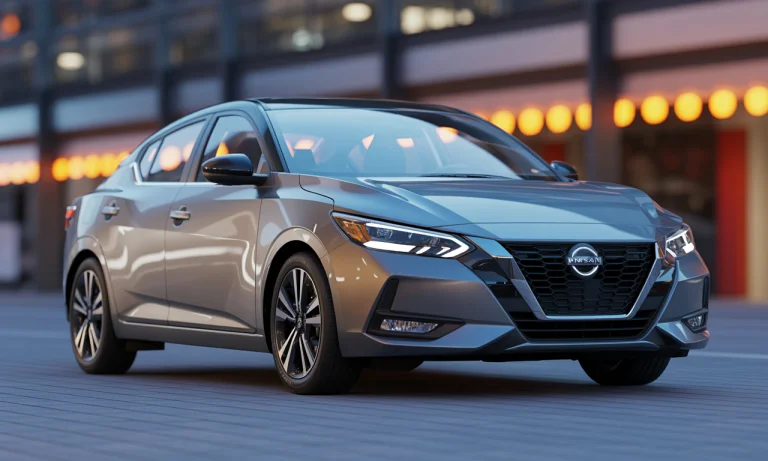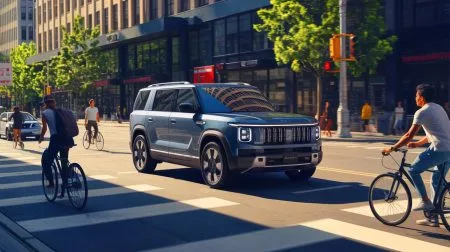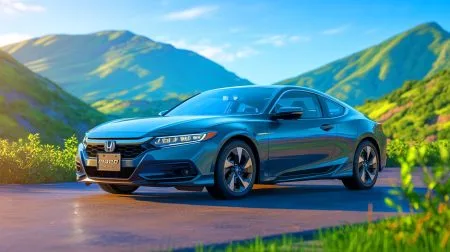Change is stirring in the compact sedan market, where familiar shapes and trusted names have long defined the streets. In an automotive landscape shifting toward SUVs and electric vehicles, Nissan continues to bet on the enduring appeal of the sedan. The all-new Sentra, revealed under the glare of regulatory spotlights in China, is more than just a generational update. With design cues echoing Nissan’s new era, dimensions that hint at a more imposing posture, and the possibility it may soon become the brand’s sole sedan, this upcoming arrival stands as a pivotal chapter for car buyers longing for style and substance. As competitors like Toyota, Honda, Mazda, Hyundai, Kia, Ford, Chevrolet, and Volkswagen rework their own offerings, the 2026 Sentra promises to spark conversations and redefine expectations in a segment many believed to be quietly fading away. The story of its official unveiling in the U.S. is just beginning, but the clues are compelling and the anticipation palpable.
Fresh Styling: Nissan Sentra’s New Design Language and Visual Presence
The 2026 Nissan Sentra enters the scene with a silhouette that both commands attention and aligns with Nissan’s recent design philosophy. The front end, defined by a reimagined grille and slim headlamps with fang-like LED accents, conjures echoes of European aesthetics—most notably the Peugeot 508. For fans familiar with the outgoing Sentra and its Chinese sibling, the Sylphy, this transformation is not simply about sharper contours; it’s about attitude. The front grille’s intersecting lines draw the eye to the midsection, while the slender lighting signature underscores a new-found sophistication.
The rear profile continues the narrative, as a light bar spans the trunk lid and unites crystal-clear taillights. A discreetly integrated spoiler stretches visually across the width, giving the family sedan a sportier lean than ever before. Even as Nissan’s sedan roster contracts—following recent reports that the Versa and Altima could face discontinuation—Sentra’s refresh signals the brand’s ongoing investment in drivers who value tradition with a modern twist.
| Model | Length (in) | Width (in) | Height (in) | Wheelbase (in) |
|---|---|---|---|---|
| 2026 Nissan Sentra (Sylphy – China) | 183.3 | 71.9 | 57 | 106.7 |
| 2025 Toyota Corolla | 182.5 | 70.1 | 56.5 | 106.3 |
| 2025 Honda Civic | 184.0 | 70.9 | 55.7 | 107.7 |
The Global Rivalry: Nissan vs. Toyota, Honda, and More
Across continents, car enthusiasts have watched as the battle for compact sedan supremacy played out. While Honda’s Civic and Toyota’s Corolla have set benchmarks for the class, others—such as Mazda’s refined 3, Hyundai’s bold Elantra, Kia’s value-packed Forte, and entries from Chevrolet, Ford (once with the Focus), and Volkswagen’s Jetta—have each injected distinct personalities. The Sentra’s latest iteration seeks not just to compete, but to carve out its own lane. In the college parking lots and suburban driveways where these vehicles are judged, small enhancements in design and comfort can tip the scales. According to analysts following future affordable models, the Sentra’s updates may arrive just as rivals adjust their own strategies, introducing higher-tech standards and unexpected flourishes in a bid for buyer attention.
Brand loyalty remains strong, helped by memorable advertising campaigns and word-of-mouth recommendations. Nissan knows this, making each Sentra iteration an implicit promise not only to retain existing fans but to tempt those weighing options from Mazda, Hyundai, Kia, and beyond. For many, the exterior isn’t merely about aesthetics but about making a statement in day-to-day life.
Specs, Space, and Substance: New Dimensions and Powertrain
Peering beneath the surface, the China-spec Sentra (Sylphy) arrives with a naturally aspirated 1.6-liter four-cylinder engine, delivering 133 horsepower. Although this may seem modest next to turbocharged rivals, it’s paired with efficiency and reliability—qualities long favored in the segment. With the lightest variant weighing in at 2,875 pounds, the balance between weight and handling promises familiarity but with a slightly bolder feel. Key dimensional increases over the previous model, notably a gentle stretch in length and width, create the impression of a larger, more secure vehicle without sacrificing agility or comfort.
Inside, details remain closely guarded, but leaks and prior upgrades suggest a digital-forward approach. Expect crisp screens, enhanced driver aids, and improved materials—all elements that appeal to city commuters and families alike. Still, concrete confirmations await the official U.S. reveal, anticipated at a major American auto show before the close of the year.
| Feature | 2026 Nissan Sentra | 2025 Mazda 3 | 2025 Hyundai Elantra |
|---|---|---|---|
| Base Engine | 1.6L I4 (133 hp) | 2.0L I4 (155 hp) | 2.0L I4 (147 hp) |
| Estimated MPG | Likely 33/41* | 28/37 | 32/41 |
| Infotainment | Digital (TBA) | 8.8″ Display | 8″/10.25″ Display |
*Projected values based on segment trends; for more on fuel efficiency leaders, see this overview.
Production, Pricing, and Where Sentra Fits in the Market
There are indications that Nissan might relocate production for the U.S. Sentra to Mississippi, seeking to avoid potential tariffs and cement its American foothold. Pricing remains speculative, yet industry watchers anticipate modest increases from the previous entry point near $22,785. In an ecosystem where competitors routinely fine-tune incentives, features, and guarantees, Nissan’s decisions here may have ripple effects among price-sensitive buyers and fleet managers.
The decision carries echoes of past automotive pivots. Ford surprised many when it stepped back from sedans; conversely, this gamble may allow Nissan to occupy a less crowded space, leveraging the Sentra’s reputation for value and predictability. For customers comparing offers from Toyota, Honda, Mazda, and Hyundai, the sense of narrative continuity—tracing a model’s evolution through decades—carries its own appeal.
Sentra’s Road Ahead: What Shoppers and Enthusiasts Should Expect
With the U.S. debut still ahead, the Sentra stands at a moment of tension and opportunity. Will it become the last sedan standing in Nissan’s showroom, or set a new standard for combustion-powered compacts amid an era of electrification? History shows that shifts often spark innovation: Mazda’s storytelling around the Mazda 3, Hyundai’s technological leaps in the Elantra, and Volkswagen’s upgrades to the Jetta remind us that reinvention is often rewarded. Nissan’s challenge will be to ensure that this new Sentra not only matches but surpasses the expectations built by generations before.
For those tuning into the automotive rumor mill or standing at the crossroads of a purchase decision, the Sentra’s evolution won’t go unnoticed. Its very existence offers proof that sedans, at their best, remain relevant—especially when they dare to change with the times. As other brands recalibrate, the Sentra’s sharper look and strategic tweaks serve as an invitation for drivers to rediscover what they cherished about cars in the first place.
| Brand | Upcoming Sedan | Key Enhancement |
|---|---|---|
| Nissan | Sentra 2026 | Bolder design, refined tech, possible U.S. build |
| Toyota | Corolla 2025 | Mild hybrid update, updated safety suite |
| Mazda | Mazda3 2025 | Redesigned infotainment, premium interior |
| Volkswagen | Jetta 2025 | Styling tweaks, better connectivity |
| Hyundai | Elantra 2025 | Edgier look, wireless features |
Key Questions About the New Nissan Sentra—Answered
When will the all-new Nissan Sentra be officially revealed in the U.S.?
The debut is anticipated at a major U.S. auto show, potentially as early as November, where all official details will be made public.
How does the 2026 Sentra compare to the latest Honda Civic and Toyota Corolla?
The Sentra is slightly larger in certain dimensions and features a distinctive new design, though it keeps to a naturally aspirated engine; Corolla and Civic continue to offer their own unique tech and powertrain options.
Will Nissan discontinue other sedans, making Sentra the only one left?
Reports suggest the Versa and Altima may be phased out, potentially leaving the Sentra as Nissan’s sole sedan. The brand’s focus would sharpen on making Sentra as competitive as possible.
What powertrain can U.S. buyers expect in the 2026 Sentra?
While China receives a 1.6L engine, final U.S. specs remain unconfirmed, though a naturally aspirated four-cylinder seems likely, emphasizing efficiency and ease of maintenance.
How does the Sentra’s redesign address current buyer trends?
The sharper styling, improved perceived quality, and potential jump in digital features align with shifts seen at Toyota, Mazda, and Hyundai—targeting younger buyers and tech-savvy families.
Did you like it? 4.4/5 (29)







